Liberty Bridge
Liberty Bridge is the third and shortest bridge of Budapest. It was built for the Millennium World Exhibition in 1896, its original name being Francis Joseph Bridge.
It was built to plans resulting from a design competition held in 1893. Originall, it was named Fővám Square Bridge after the Fővám Palace, which currently hosts the Budapest Corvinus University, formerly known as Budapest University of Economics. The bridge was designed by János Feketeházy, chief engineer of the Hungarian Railroads at that time. Construction was started in June 1894. It was inaugurated by Francis Joseph I, who hammered in the last silver rivet on the Pest side on 4 October 1896, at the festivities held for the thousand-year jubilee of Hungary. The bridge was named Francis Joseph after the Emperor. Two years later, in 1898 tramway traffic was started on the bridge.
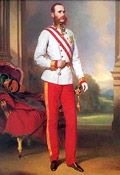 Emperor Francis Joseph (1830-1916) |
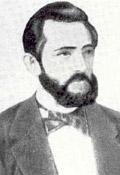 János Feketeházy (1842-1927) |
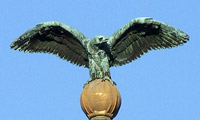 Turul bird on top of the pilar |
Liberty Bridge can be classified as a three-span girder bridge with a Gerber truss built in Art Nouveau style. It is 333.6 meters in length, 20.1 meters in width. Lateral swings are hindered by its wind tie structure. Both portals are decorated with the coat of arms of Hungary designed by Virgil Nagy and two Turul statues each. Turuls are falcon-like birds, prominent in ancient Hungarian mythology.
Custom-houses have been built at both ends of the bridge, directly at the abutments. They are composed of two storys, the ground floor containing an entrance hall, two smaller rooms and a larger one. The smaller rooms were used to hand out tickets, the larger one for money hoarding and the storage of various instruments. The first floor hosts only one room, which served to accommodate the custom-house officers. Plaques commemorating the date of the building and the re-building of the bridge have been embedded in the facades of the custome-houses. You can also find plaques on the pillar columns with the names of the bridge's designers and engineers. Custom-houses on the Buda side were demolished at the time of its reconstruction. Since 2002, you can visit an exhibition presenting the Danube bridges of Budapest in the custom-house at the northern side of the Pest end, which is open on Mondays and Thursdays between 10 A.M. and 2 P.M.
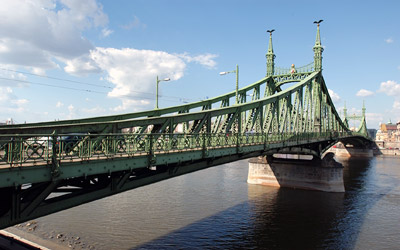
Liberty Bridge is the shortest bridge of Budapest
During World War II, on 16 January 1945, Francis Joseph Bridge, as every other bridge in Budapest, was blown up by retreating German troops. After the end of the war, it would be the first bridge to be reconstructed. Its state was not irreparable, only its central parts had to be rebuilt. It was reopened for traffic on 20 August 1946, its new name being Liberty Bridge. It meant also the first time after the liberation of Hungary that a tram connecting Buda and Pest crossed the bridge.
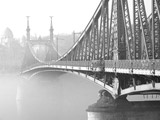 Liberty Bridge in early morning fog |
Fővám Square is situated at the Pest end of the Bridge. Its most distinguished point of interest is the Market-Hall, to be found right next to the buildings of Budapest Corvinus University. It is the largest roofed market of the Hungarian capital with the finest, largest and richest range of goods, where you can buy everything from fresh vegetables to fruit, meat and various spices. Fővám Square can be approached the easiest way from the Kálvin Square station of M3, from which it is at a ten minutes' walk, or from Deák square with the trams 47 and 49 which also cross Liberty Bridge. As Liberty Bridge is the shortest bridge in Budapest, you can easily walk across it over the Danube in a couple of minutes.
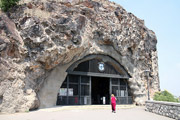 Entry of the Cave Church |
Having reached the Buda end of the bridge, you get to Gellért Square at the foot of Gellért Hill, hosting Hotel Gellért famous for its thermal water. At the right side of the Hotel, you can find the Cave Church with the statue of Stephen I before it. From here, the top of Gellért Hill with the Citadella and the Liberty Statue, standing proudly over Budapest, are only a 15-20 minutes' comfortable walk.
|
|||||||||||||||||||||||||||||||||||||||
|
|||||||||||||||||||||||||||||||||||||||
External links
- Hotel Gellért - A typical spa hotel with famous thermal bath and pool
- Citadella - The Citadella is situated at Gellért Hill with beautiful view of Budapest
BRIDGES OF BUDAPEST
DID YOU KNOW?
At its inauguration in November 1950, the current Arpad Bridge was named after Stalin instead of the originally proposed Arpad by the socialist government. Finally, it was rechristened Arpad in 1958.Read more


